#army regiment
Text

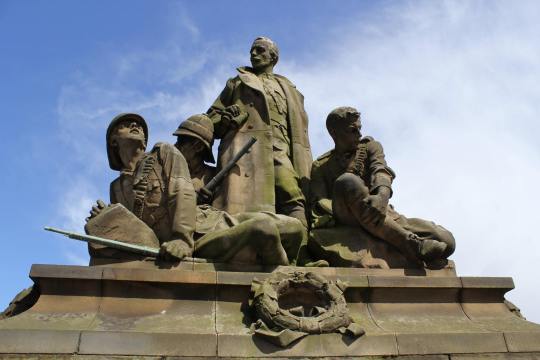
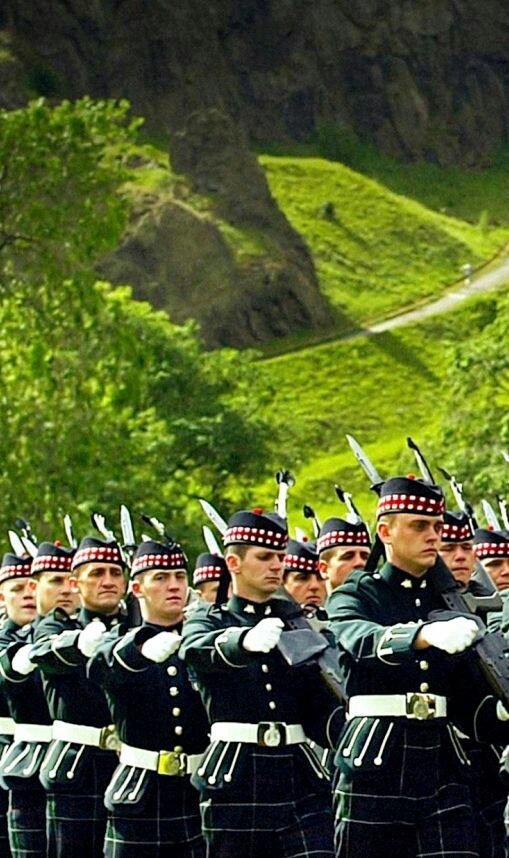

March 18th 1689 saw the Earl of Leven raise a Border regiment to hold Edinburgh against the Jacobites.
Leven’s letter of authority read ‘The Committee…may be pleased to grant warrant to the Earl of Levin, with all expedition to levie ane regiment of foot consisting of eight hundred men, and to beat drummes to that effect. And that so soon as they are in readiness, he cause them Rendezvous in the Abbey Close....
In what is said to have been something between two and four hours, Leven raised 780 men ‘by beat of drum’ and mustered them as ordered by the ruins of the Abbey Church at Holyrood.
The regiment first saw action at the Battle of Killiecrankie on July 27th of that year and, although the Jacobite rebels forced the Government army to retreat.
18 notes
·
View notes
Photo


1st Lieutenant James Reese Europe and the 369th Infantry Regiment Band (the Harlem Hellfighters) play for patients in the American Red Cross Hospital No. 9, Paris, France, September 4, 1918.
Record Group 111: Records of the Office of the Chief Signal Officer
Series: Photographs of American Military Activities
Image description: 1st Lieutenant Europe conducts a brass band who are standing in rows outside a building. All of the men are wearing WWI Army uniforms. A sign in the background reads HOTEL TUNIS. This regiment, the “Harlem Hellfighters,” was made up of all Black soldiers.
Transcription:
SUBJECT: 111SC 218880
NUMBER E
see 20417
2nd Lt. G. E. Stone, S.C.
PHOTOGRAPHER
REC'D 10-14-18
TAKEN 9-4-18
FIRST LT. JAMES E. EUROPE OF the 369th Regt. Inf. playing for the patients of Hospital No. 9. Sgt. Wood Andrews is the first musician on the right and plays the slide trombone. American Red Cross Hospital No. 9, Paris, France.
#archivesgov#September 4#1918#1910s#World War I#WWI#Black history#African American history#369th Infantry Regiment#Harlem Hellfighters#military#U.S. Army#band#music#trumpet#trombone#James Reese Europe
199 notes
·
View notes
Text
Today a little excursion ashore and to a topic that may seem a little strange. But I'm currently working on a little project about the Household Cavalry Mounted Regiment (dating from 1660) and the Navy (please don't ask any questions yet, I'm still collecting documents). You may have seen these gentlemen and a few ladies at parades in London or somewhere else. They are on horseback and perform mounted (and some dismounted) ceremonial duties at state and royal occasions and consist of two regiments: The Life Guards and The Blues and Royals (Royal Horse Guards and 1st Dragoons) and they are the King's official bodyguards.
You might ask me now: Yes, fine, and what does that have to do with nautical matters? Well, there is a small but subtle detail on the Life Guards uniforms.

A Life Guard officer in full ceremonial uniform
You can see this hair-like detail on the helmet. That's the white plume, which in the past, but especially in the 18th and 19th centuries, was not made from hair, but from whale bone shavings from corset shops. Exciting what whale was used for.
I thought I'd share this little fact with you, maybe you'll find it as interesting as I did.
74 notes
·
View notes
Text
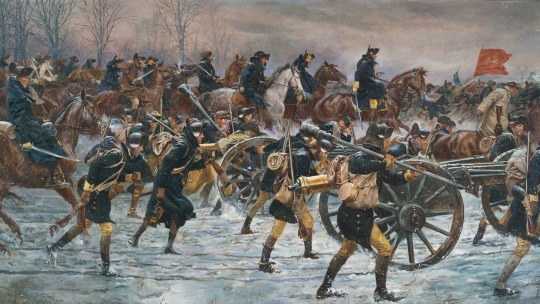
Victory or Death, Advance on Trenton by Don Troiani
#don troiani#art#american revolution#american revolutionary war#alexander hamilton#george washington#artillery#cannons#history#american#america#north america#continental army#trenton#virginia regiment#flag
55 notes
·
View notes
Text
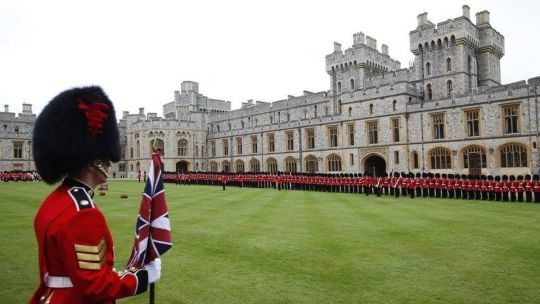
Formed in 1660, the Coldstream Guards are Britain's oldest regiment
#Coldstream Guards#Windsor Castle#Berkshire#bearskin caps#British Army#military history#royal regiment#uniforms#Union flag#regimental colours#tradition#UK
116 notes
·
View notes
Text

Mitrailleuse MG 34 du 141st Gebirgsjäger Regiment de la 6e Division de montagne – Guerre de continuation – Péninsule de Kola – Union soviétique – Avril 1942
#WWII#front est#eastern front#guerre de continuation#continuation war#armée allemande#german army#wehrmacht#heer#6e division de montagne#6th mountain division#141st Gebirgsjäger Regiment#armes d'infanterie#infantry weapon#mitrailleuse#maschinengewehr 34#mg 34#péninsule de kola#kola peninsula#union soviétique#soviet union#urss#ussr#04/1942#1942
78 notes
·
View notes
Text
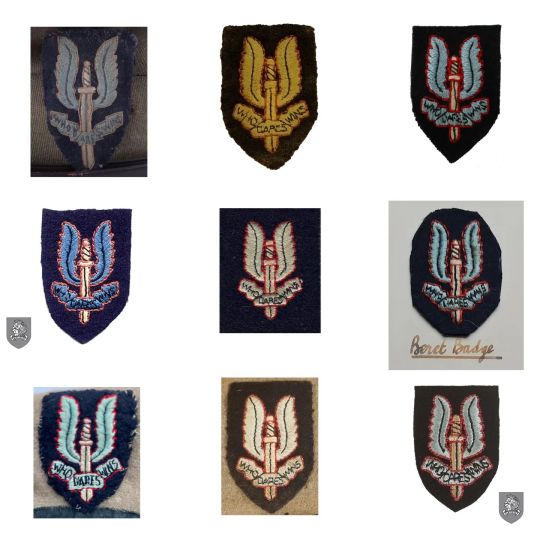
The badge was meant to be a flaming ‘Excalibur’ - recalling the Lewes bomb that contained both plastic explosive and inflammable thermite with time pencils. I knew that, but most of us called the stylised badge a ‘winged dagger’ and it made a better title for a book than ‘Flaming Sword’ ‘Who Dares Wins’ etc. the sword looks more like a commando knife and was certainly not meant to be a ‘Sword of Damocles’.
Roy Farran, ‘Winged Dagger’ (1948)
The badge of the Special Air Service was created by Corporal Bob Tait in October 1941, who would survive the war and die in retirement in 1975.
Robert ‘Bob’ Duncan Tait was a founding member of ‘L Detachment’, later the SAS, and is credited with the design of the most coveted military badge in the world: the SAS winged dagger. Tait was part of 11 Commando before he was invited to join L Detachment under the direction of Col. Stirling while fighting in North Africa in World War Two.
He survived the regiment’s first disastrous operation: a parachute drop in support of the Operation Crusader offensive in Libya in November 1941. It proved to be an unmitigated disaster when 22 men out of 60 were either killed or captured by the Germans.
The second was far more successful and saw Bob Tait as one of five commandos who snuck into a German aerodrome deep behind enemy lines and laid explosives that destroyed 37 aircraft. The raid secured the future of the SAS as it convinced military chiefs a specially trained unit that could operate behind enemy lines was needed.
In between the raids, the members of the newly formed unit held an informal competition to design the insignia for the regiment. Tait’s design of King Arthur’s Excalibur sword - not a dagger as commonly thought - with light blue wings either side of it was voted the best by the rest of the men and is the cap badge still in use today.
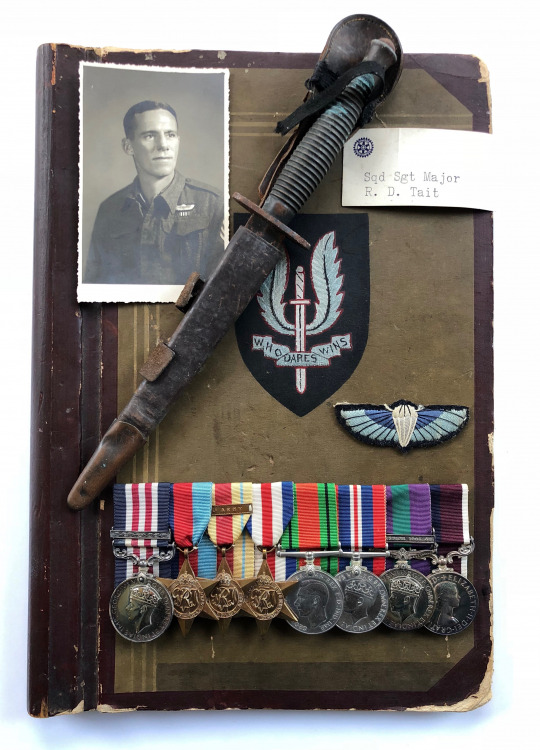
The SAS insignia represents King Arthur’s flaming sword Excalibur - not the dagger as it came to seen as. Indeed the name ‘the Winged Dagger’ appears to have first been published in a SHAEF communique of 1944 which was then quoted in the Sunday Times and Observer newspapers.
Having already been awarded a Military Cross and Bar with the 3rd Hussars, Roy Farran joined 2nd SAS in 1943. Although not serving with the Regiment when the insignia were developed, his book, ‘Winged Dagger’ was truly the first book to shed light on the SAS when it was published in 1948. The image of the ‘winged dagger’ stuck in the public consciousness.
Early examples were made up by Cairo tailors and many variants can be seen.
By March 1944, the 1st and 2nd SAS Regiments returned to the United Kingdom and joined a newly formed SAS Brigade, a component of 1st Airborne Corps, commanded by Lieutenant General Frederick ‘Boy’ Browning, with Brigadier Roderick McLeod in charge of the SAS. Many more badges would be required, and it was essential that a standardised design was agreed upon - see top right.
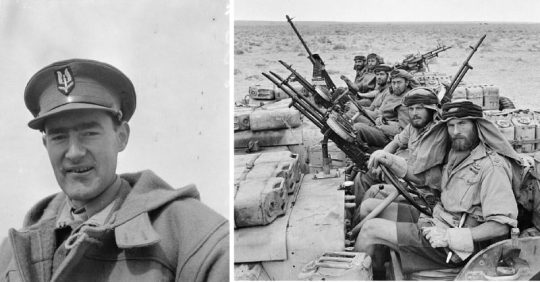
In March 1951 the Malayan Scouts adopted the maroon beret and the badge of the Special Air Service and this was worn by the members of 21 SAS who formed the new B Squadron - see centre left. The instruction that brought the Malayan Scouts into the British Army Order of Battle as 22 SAS Regiment dates from 16th July 1952.
The central badge was worn by 21 SAS on the right arm when it was formed in 1947. At that stage they wore the Mars and Minerva cap badge of the Artists Rifles on their maroon berets which was of similar design. However, in 1956, these were swapped, and the design of the beret badge was published in that year (rather curiously on a crudely cut out backing)
The 1956 badge was worn throughout the 1960s - see bottom left. But this had become somewhat anaemic by the early 1980s. The current pattern is shown bottom right.
#farran#roy farran#quote#SAS#the regiment#colonel david stirling#bob tait#SAS insignia#cap badge#british army#L detachment#military#military histoey#sUK special forces#special forces#second world war#excalibur#winged dagger#uniform
104 notes
·
View notes
Text
The heavens opened for today's gun salute! ☔️
Watch the HAC Regiment fire a 62-round gun salute at the Tower of London for His Majesty The King's Birthday. 👑🎉
14 November 2023
—
The Honourable Artillery Company (HAC) is the oldest regiment in the British Army with a long history of tradition and excellence.
HAC soldiers take great pride in their ability to switch quickly and seamlessly between serving their country on operations and performing ceremonial duties in the City of London.
The HAC is the Army Reserve’s Intelligence, Surveillance and Reconnaissance Regiment.
It exists to support the Regular Army on operations.
We work closely and train with our two paired regiments — 5th Regiment Royal Artillery and 7th Parachute Regiment Royal Horse Artillery.
#King Charles III#Charles III#His Majesty The King#HMTK#Honourable Artillery Company (HAC)#British Army#HAC Regiment#gun salute#British Royal Family#Tower of London
23 notes
·
View notes
Text
I've been writing some smut for two of my OCs in the Turn fanfic You've Caught Me Between Wind and Water, Lt. Jameson Mullcock and Lt. Frederico Ridgewell. It's going really well, so well in fact that I might end up submitting it to an erotica magazine in the future--which would prevent me from posting it on AO3.
To that end, to cover my own disappointment, here's some bits of lore for these two, gratis:
Background
Frederico
Full name is Frederico “Dico” Miguel Carvalho dos Reis Ridgewell
He is a Portuguese-American (mother is Portuguese) and stands in for the many Portuguese-American contributions to the Continental Army (go look up Pedro "Peter" Francisco)
Father split when Frederico was young, he grew up with his mother in New York in a Portuguese neighbourhood
Speaks fluent Portuguese
James
Jameson Mullcock is just Jameson Mullcock, but he goes by James
He is Irish-American and stands in for the many Irish-American contributions to the Continental Army (I explicitly wanted to include an Irish-American character because there were shitty stereotypes in the army against the Irish from other nationalities; like, we have primary sources for this)
James does not disclose he is half-Irish when he enlists and just lists his birthplace as Philadelphia
His mother is Abaigeal Noiréis (Abigail Norris), born in Galway, Ireland (thank you @mercurygray for naming her and helping me with her backstory!)
She is Catholic and married a Protestant British soldier she met during the occupation of Ireland, then followed him to England and then Pennsylvania and had to keep her faith secret
James is raised Protestant and only knows a little of the Catholic faith, which he keeps secret (because there was a considerable anti-Catholic sentiment in parts of the colonies)
Knows a little bit of Irish and wishes he knew more but doesn't think he'd be welcome (or feel comfortable) among the Irish soldiers and officers
Personality and looks
Frederico
olive skin, dark eyes, tousled dark hair
enough weight on him to look conspicuously healthy at Valley Forge in 1777
exactly as athletic as he looks but not quite as intelligent
drop dead gorgeous and doesn't care
cinnamon roll, too pure for this world, is the only one unaware that people believe this of him
a dark horse so dark you can't even see him coming
James
pale enough to look anemic, eyes and hair too light for people's comfort
tall, gangly; gaunt, even by Valley Forge standards
more athletic than he looks and more intelligent too
sarcastic slacker who's too smart to let people know how much more responsibility he's capable of taking on
has maybe two vices (tea and tobacco) that he'll hold onto, everything else he's already resigned himself to losing
would rather light his arm on fire than go after something he wants in a direct, open, and honest manner (and be Seen? Are you mad?)
Occupation
and the whole reason I put this post together, which is to remind future Apfel that they are 2nd LIEUTENANTS in LAMB'S CONTINENTAL ARTILLERY which was reorganized in 1777 from LAMB'S INDEPENDENT COMPANY NEW YORK ARTILLERY which drew from artillery companies in NEW YORK, CONNECTICUT AND PENNSYLVANIA. OKAY??
AND ARTHUR GARRICK IS A 1ST LIEUTENANT AND CAPTAIN ARMISTEAD FOLK IS THEIR CAPTAIN. AND PERKINS IS THEIR ENSIGN. IT'S ALL ONE GROUP. REMEMBER THIS!
CALEB WAS PART OF THIS GROUP. THEY WERE ALSO IN PEEKSKILL AND AT THE WHITEMARSH ENCAMPMENT.
YOU ALREADY WROTE LAMB INTO THE STORY IN CHAPTER 8.
YOU ALREADY FIGURED THIS OUT.
YOU DON'T NEED TO RESEARCH IT AGAIN.
...
@georgios-kyriacos, I believe you expressed interest in these two :)
#Apfelessig#You've Caught Me Between Wind and Water#turn amc#my fanfic#the writing echo chamber#swear to god if I have to find another surprising connection years down the line about this freaking army#thank god that regiment drew from those exact three colonies I didn't want to have to rethink their backgrounds#long post#also Garrick's and Mullcock's name come from a Tumblr User's suggestions and i can't find the username??? I'm so sorry!!#also in looking for that information I uncovered notes from 2020 that told me that Perkins does actually have a first name#that I have never mentioned#and it is Sidney#this discovery makes me feel slightly more charitable toward him than I have ever been in the story#also Ridgewell's name was originally meant to be John
8 notes
·
View notes
Text

#dmytro kozatsky#azov battalion#azov regiment#mariupol#polish grand press photo#russian war#russia ukraine war#ukraine army#help for ukraine#ukraine#putin's war#criminal war#war#criminal putin#fuck putin#putin#stop invasion#stop russia#stop war#stop putin#russian agression
315 notes
·
View notes
Text

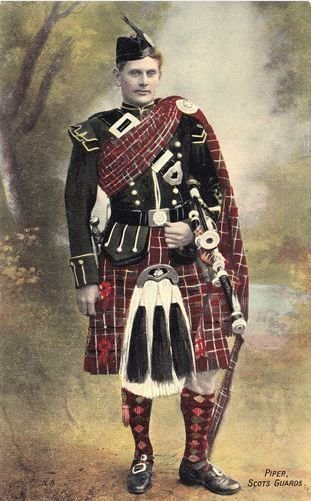


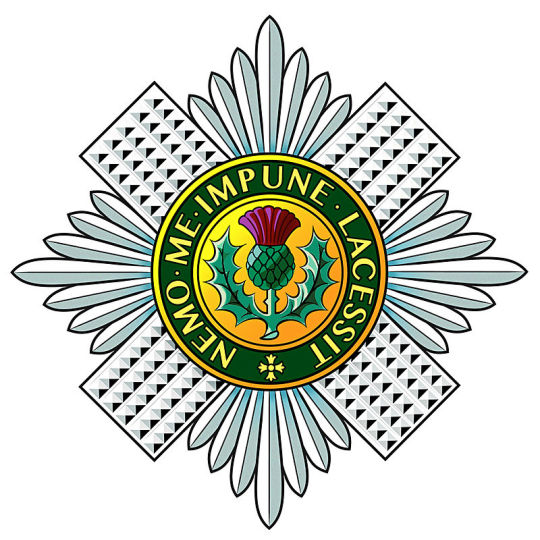
On March 28th 1642, the Scots Guards Regiment was formed.
In 1642 Archibald Campbell, the 1st Marques of Argyll, as seen in the forst pic, was also instructed by The King to raise a Royal Regiment of 1,500 men to act as Royal Guard to the King when he visited Ireland. This Regiment was named the ‘Marquis of Argyll’s Royal Regiment’ and Argyll appointed Sir Duncan Campbell of Auchinbreck as Lieutenant Colonel of the Regiment, which swiftly moved to Ireland. It remained in Ulster while Civil War raged in England and Scotland until 1649, when King Charles I was executed. The much depleted Regiment then crossed to Scotland and was referred to as the ‘Irish Companies’.
In 1650 it welcomed King Charles II to Scotland from France who was proclaimed King of Scots. The King took the ‘Irish Companies’ as his ‘Lyfe Guards of Foot’ and were soon engaged in action at the Battle of Dunbar, were the Scottish Army was defeated by Oliver Cromwell’s New Model Army. In 1651 King Charles II once again engaged the Parliamentary Forces at the Battle of Worcester and was once again defeated. The King managed to escape to France but the Regiment was scattered and ceased to exist.
King Charles II was restored to the throne in 1660 after the abdication of Richard Cromwell (son of Oliver Cromwell) as Lord Protector in 1659. The Regiment was reformed in 1661 as the ‘Scottish Regiment of Foot Guards’ and garrisoned at Edinburgh and Dumbarton Castles. The Regiment was engaged in Scotland suppressing the Convenanters uprising against the King, who challenged many of the religious reforms imposed on them, finally defeating them at the Bothwell Brig in 1679.
The regiment has fought in all major conflicts over the past 380years and nowadays comprises of the Battalion (the fighting component), F Company (ceremonial), Scots Guards Association (veterans), charity, recruiting team as well as the Pipes and Drums*
16 notes
·
View notes
Text

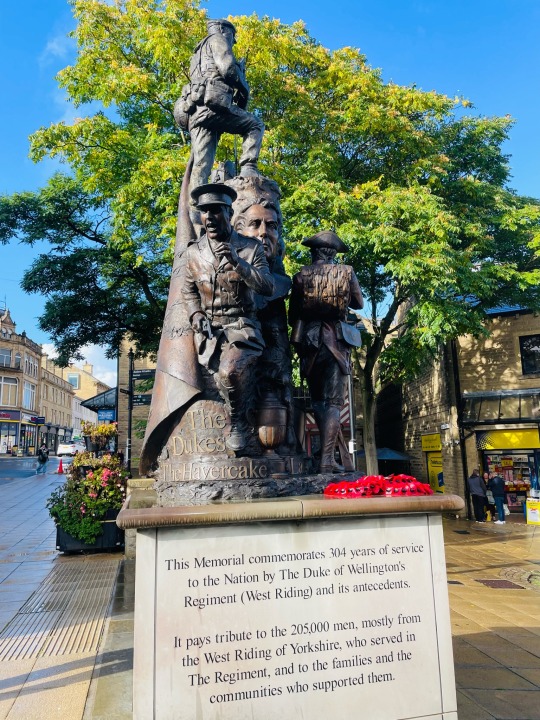

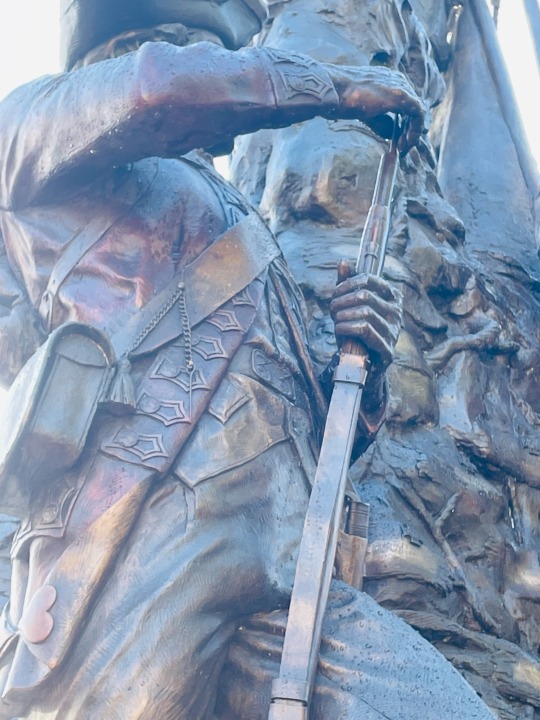


The Duke of Wellington’s Regiment’s memorial in Halifax, Yorkshire.
44 notes
·
View notes
Text
#OTD in 1971 – 9-11 | During the internment round-up operation in west Belfast, the Parachute Regiment killed 11 unarmed civilians in what became known as the Ballymurphy massacre.
On 9th of August 1971, Interment Without Trial was introduced by the British Government in the North of Ireland. This policy was implemented by the British Army at 4am on that particular summer morning. The British Army directed the campaign against the predominately Catholic community with the stated aim to “shock and stun the civilian population”.
Between 9th and 11th of August 1971, over 600…
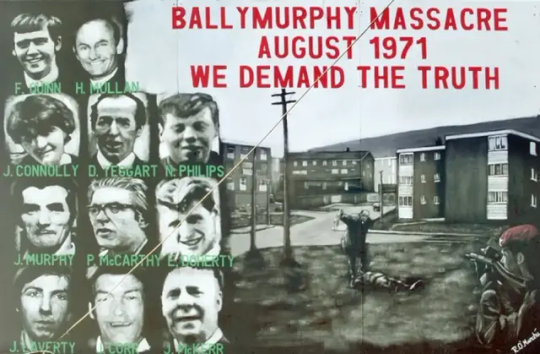
View On WordPress
#Truth Justice#Ballymurphy Massacre#British Army&039;s Parachute Regiment#British paratroopers#Daniel Teggart#Edward Doherty#England#Hugh Mullan#Irish History#Joan Connolly#John Laverty#John McKerr#Joseph Murphy#Noel Phillips#Paddy McCarthy#West Belfast
11 notes
·
View notes
Text

#harlem hellfighters#black history#black history is american history#harlem 369 regiment#black tumblr#civil rights#black literature#black excellence#black community#us army#us military
85 notes
·
View notes
Text
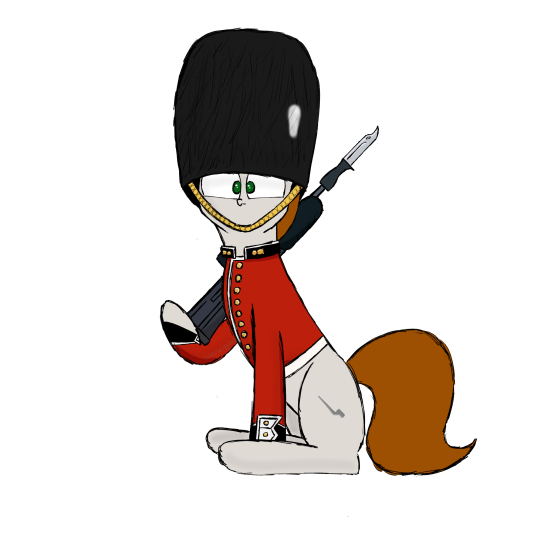
In honor of the coronation the new King, I made this quick little piece. Iron Hoof as a Grenadier Guard!
#Iron Hood#Art#Random Art#MLP#My Little Pony#Earth Pony#Grenadier Guard#Now that I think of it I should have made him as a Welsh Guard#Since his 24th Solar Regiment of Hoof was based on the British Army's 24th Regiment of Hoof#Which is now the Welsh Guards#Oh well XD
19 notes
·
View notes
Text
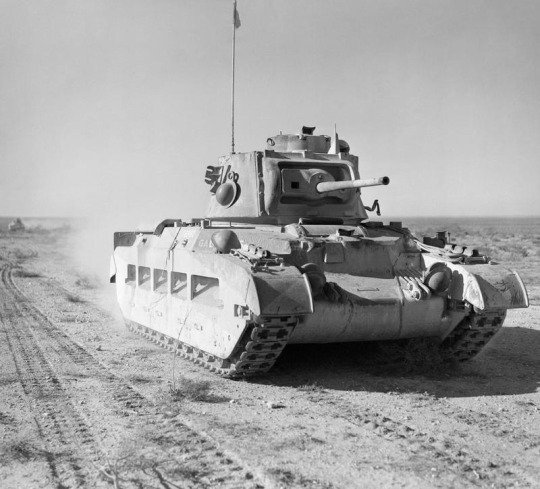
Char Matilda II du 7th Royal Tank Regiment – Opération Compass – Campagne d'Afrique du Nord – 19 décembre 1940
Photographe : Capitaine Geoffrey John Keating - No. 1 Army Film and Photo Section, Army Film and Photographic Unit
©Imperial War Museums - E 1416
#WWII#campagne d'afrique du nord#north african campaign#opération compass#operation compass#armée britannique#british army#7e régiment royal de chars#7th royal tank regiment#char#tanks#char d'infanterie#infantry tank#matilda II#afrique du nord#northern africa#19/12/1940#12/1940#1940
24 notes
·
View notes